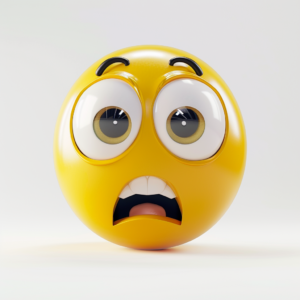Scared Face Emoji Meaning 😨
The Scared Face Emoji: A Tale of Digital Trepidation
 Introduction to the Emoji
Introduction to the Emoji
The Fearful Face emoji (😨), also known as the “Scared Face” or “Face with Open Mouth and Fearful Eyes” emoji, is a vivid representation of fear, shock, or surprise in digital communication. This expressive emoji features a yellow face with wide, frightened eyes, raised eyebrows, and an open mouth, capturing a moment of intense alarm or distress. It was added to the Unicode Standard in 2010 as part of Unicode 6.0 and has since become a popular way to convey fear, anxiety, or shock in digital conversations.
Design and Description
The Fearful Face emoji (😨) is designed to capture a moment of intense fear or surprise. Its key features include:
1. Wide, circular eyes: Representing a startled or frightened expression.
2. Raised eyebrows: Indicating alarm or shock.
3. Open mouth: Suggesting a gasp or cry of fear.
4. Yellow face: Consistent with the standard emoji color palette.
While the core design remains consistent across platforms, there may be slight variations in the emoji’s appearance:
– On iOS devices, the eyes might appear slightly larger and more pronounced.
– Android versions might show a slightly paler yellow for the face.
– Some platforms may depict the mouth as more oval-shaped, while others show it as more rectangular.
Despite these minor differences, the emoji’s fearful expression remains unmistakable across all platforms.
Cultural Significance
The Fearful Face emoji has gained significant cultural relevance in the digital age:
1. Universal emotion: Fear is a basic human emotion recognized across cultures, making this emoji universally understood.
2. Online reaction: It’s frequently used to react to shocking news, scary stories, or unexpected events shared online.
3. Meme culture: The emoji has been incorporated into various internet memes, often used to humorously exaggerate reactions to minor inconveniences.
4. Mental health awareness: In some contexts, it’s used to discuss anxiety and other mental health issues, helping to normalize conversations about fear and stress.
5. Horror and thriller genres: The emoji is often employed when discussing scary movies, books, or experiences, becoming a shorthand for the thrill of fear in entertainment.
Usage and Meanings
The Fearful Face emoji is versatile in its usage:
1. Expressing genuine fear: Used when discussing truly frightening situations or experiences.
2. Showing surprise: Often used to react to unexpected news or events, not necessarily negative ones.
3. Conveying anxiety: Employed to express worry or nervousness about upcoming events or situations.
4. Exaggeration for humor: Frequently used in a lighthearted way to overstate reactions to minor issues.
5. Empathy and support: Used to show understanding when someone shares a scary or stressful experience.
6. Warning or caution: Sometimes used to alert others to potential dangers or risks.
7. Reaction to suspense: Employed when discussing tense moments in stories, movies, or real-life events.
Controversies or Misinterpretations
While generally straightforward in its meaning, the Fearful Face emoji has faced some challenges:
1. Intensity misinterpretation: Its intense expression might be seen as an overreaction in some contexts, potentially leading to misunderstandings.
2. Cultural differences: In some cultures, openly expressing fear might be less common, affecting how the emoji is perceived and used.
3. Mental health stigma: When used to discuss anxiety or phobias, it might unintentionally trivialize these conditions for some observers.
4. Overuse in non-fearful contexts: Its frequent use in humorous or exaggerated contexts might dilute its impact when expressing genuine fear.
5. Confusion with similar emojis: It might be confused with other surprised or shocked face emojis, leading to misinterpretation of the intended emotion.
Impact on Language and Communication
The Fearful Face emoji has significantly influenced digital communication:
1. Emotional nuance: It allows users to quickly convey complex fearful emotions that might be difficult to express in words alone.
2. Tone indication: In text-based communication, it helps clarify the tone of a message, preventing misunderstandings.
3. Cultural shorthand: It has become a part of internet culture, used to react to a wide range of situations beyond just fear.
4. Visual storytelling: In social media posts and messages, it adds a visual element that enhances the narrative or emotional impact.
5. Cross-language communication: As a visual symbol, it helps convey fear and surprise across language barriers.
Emoji Combos and Explanations
Here are some commonly used emoji combinations that include the Fearful Face emoji (😨):
- 😨 + 😱: Expressing extreme fear or shock.
- Example: “Did you see that horror movie? 😨😱”
- 😨 + 😰: Indicating anxiety or nervousness.
- Example: “I have a big exam tomorrow and I’m so nervous 😨😰”
- 😨 + 😳: Showing surprise and fear simultaneously.
- Example: “I can’t believe what just happened! 😨😳”
- 😨 + 😭: Expressing fear and sadness.
- Example: “That news is so scary and sad 😨😭”
- 😨 + 😬: Indicating fear and awkwardness.
- Example: “I have to give a speech in front of everyone 😨😬”
- 😨 + 🏃: Showing fear and the urge to run away.
- Example: “I saw a huge spider in my room 😨🏃”
- 😨 + 👻: Playful fear related to ghosts or supernatural things.
- Example: “Let’s watch a ghost story tonight 😨👻”
- 😨 + 🕷️: Expressing fear of spiders.
- Example: “There’s a spider in the bathroom 😨🕷️”
- 😨 + 🌩️: Fear of storms or natural disasters.
- Example: “The storm outside is really scary 😨🌩️”
- 😨 + 🚨: Reacting to an emergency or alarming situation.
- Example: “There’s been an accident nearby 😨🚨”
- 😨 + 🏥: Fear related to hospitals or medical situations.
- Example: “I have to go to the hospital for a check-up 😨🏥”
- 😨 + 📉: Fear of financial loss or decline.
- Example: “The stock market is crashing 😨📉”
- 😨 + 📰: Reacting to shocking news.
- Example: “Did you read the news today? 😨📰”
- 😨 + 🧟: Fear of zombies or apocalyptic scenarios.
- Example: “Watching a zombie movie tonight 😨🧟”
- 😨 + 🔪: Fear related to danger or threats.
- Example: “That thriller movie was intense 😨🔪”
These combinations are often used to convey a range of emotions involving fear, anxiety, and surprise, adding depth and context to digital communication.
Example Sentences
1. “I just saw the scariest movie ever! 😨”
2. “Did you hear about the earthquake? Stay safe everyone! 😨”
3. “I have a big presentation tomorrow and I’m so nervous 😨”
4. “A huge spider just crawled across my desk 😨”
5. “Breaking news alert just popped up on my phone 😨”
6. “I can’t believe I forgot about the test today 😨”
7. “The roller coaster was way more intense than I expected 😨”
HTML and Unicode Codes
1. Decimal HTML Entity: 😨
2. Hexadecimal HTML Entity: 😨
3. Unicode Character(s): U+1F628
Conclusion
The Fearful Face emoji (😨) has become an integral part of digital emotional expression, allowing users to convey fear, shock, and anxiety in a visually impactful way. Its widespread use across various contexts demonstrates the complex role emojis play in modern communication, adding nuance and depth to text-based interactions. As digital communication continues to evolve, this emoji remains a powerful tool for expressing one of our most primal emotions in the digital realm, bridging the gap between written words and facial expressions in our increasingly online world.
https://hop.clickbank.net/?affiliate=yoloki&vendor=soundhealr&pid=gift2&tid=
